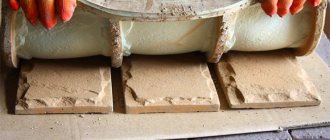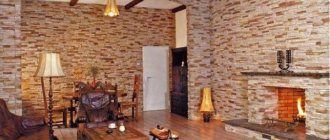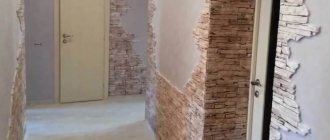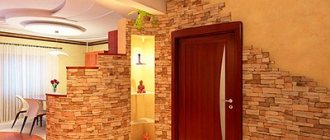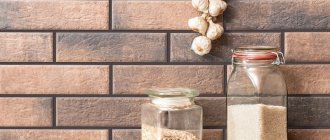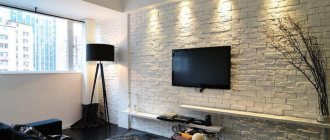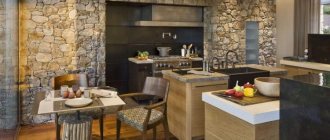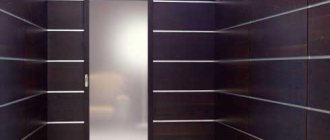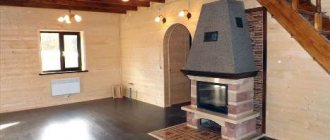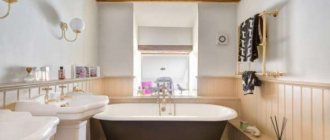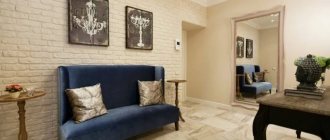Advantages and disadvantages of using 3D panels
To understand why such products have become popular, you need to weigh all the positive aspects and compare them with the negative.
Advantages:
- the ability to isolate defects in walls and communications, including electrical wiring;
- prices for many designs are quite affordable;
- a wide range of products of different materials;
- ease of installation;
- Possibility of installation on imperfectly flat surfaces;
- the ability to make the space visually wider;
- originality of design.
Flaws:
- you can make mistakes and miscalculate the interior design;
- it’s easy to make a room not stylish, but pretentious;
- difficult to replace. It is not always easy to find exactly the same damaged slab;
- eye fatigue from prolonged contemplation of a three-dimensional drawing.
As they say, think for yourself, decide for yourself... But if you approach everything wisely and with arrangement, you can get a very interesting room design.
Benefits of gypsum
To summarize, here are some of the strengths:
- provides a smooth surface without cracks and chips, which are easily masked with plaster in the same way as seams;
- using lighting you can increase the volumetric effect;
- air circulation in the room. The natural origin of the material provides a natural ability to regulate the climate and humidity in the room;
- provides good aesthetic and functional features;
- due to the low price, you can even make a professional project with a designer at an affordable price;
- many amazing design options;
- ease of installation;
- Gypsum plaster can be used as a final finish without the use of paint. The white finish gives a clean look.
interior of the apartment, interior design.
VIDEO: How to lay and paint gypsum stone?
Gypsum tiles in the interior
Imitation of unpainted tiles
Brick finishing options
You can make a brick wall indoors a reality by using ready-made factory-produced tiles, or you can recreate everything with your own hands from scrap materials.
- As a factory product, artificial brick-like stone is produced from the following components:
- Decorative bricks made of resin and a special polymer base. In this case, it becomes possible to produce white, burnt, red, beige or combined bricks. In appearance, the products are indistinguishable from natural bricks. This material is characterized by its light weight, ease of cladding, resistance to temperature changes and moisture, which allows it to be used for cladding Russian stoves and fireplaces, and work surfaces in kitchens. It is also characterized by a long service life and ease of maintenance;
- Bricks made of burnt slate clay, indistinguishable from the original. They have good wear-resistant properties, but their weight is more significant;
- Gypsum tiles are made on the basis of gypsum, are easy to install, painted in the desired shade, but they are quite fragile, but they are available in a price range and are often used for room decoration;
- Fiber cement brick panels have a very long service life, as they are made on the basis of cement and stone, have an aesthetic appearance and meet all the requirements for environmental friendliness, are very durable, but are most often used to imitate a brick wall on the facade of a building, since they have significant weight.
Imitation of a brick wall using gypsum tiles
- To create an exclusive interior, you can complete the entire process yourself, recreating a decorative brick wall in your apartment using the following materials:
The simplest option is to use paintable wallpaper with a brick textured finish. Using construction tape, squares on the wallpaper are pasted over, everything is covered with an even layer of acrylic paint, after it dries, the tape is carefully removed. It turns out quickly, cheaply, but not entirely durable and realistic;
Brick wallpaper
Decorative plaster - no special preparatory work is required to cover the walls evenly, the process is quite quick, but at the same time, masonry can only be recreated on the wall, and it is not always able to replace real brickwork;
Decorative plaster with imitation brick
Decorative bricks made of foam plastic and plasterboard sheet. A convenient option when working with frame structures and curved walls, it is quite labor-intensive, but the appearance is very realistic. The big disadvantage is the increased flammability and toxicity of polystyrene foam. A fairly inexpensive option for recreating decorative brick;
Imitation of decorative stone
Remember how popular gypsum slate tiles were in hallway interiors? Often it was used to decorate the doorframe around the front door up to the ceiling. And protruding corners, niches and arches were trimmed in the same way. I must say, such decor is a thing of the past. Today, imitation of decorative slate is extremely rare in design projects. It was replaced by slabs of marble, porcelain stoneware and other textured building materials.
Where can decorative slate be used? First of all, this is the decoration of the fireplace. But we are talking specifically about the external cladding; the internal cladding is best done with more heat-resistant materials, for example, artificial and natural stone, or real brick. False fireplaces can be finished completely.
Instagram @raykon_construction
Instagram @fid_anapa
Instagram @biokamin_ru
Instagram @zz_interior
From a stylistic point of view, a fireplace is a fairly neutral design element. So plaster cladding will be appropriate in any style: Scandinavian, eco, modern, rustic; examples in chalets are especially good. Options in white, black and gray colors - the most neutral, terracotta and natural shades look more contrasting.
In addition, similar tiles are used to decorate an accent wall. Moreover, it is the examples with partial finishing that look better. On a large wall, this texture looks too sharp and active.
Decorative gypsum stone tiles are less versatile in the interior than brickwork. Examples of its not very successful use in the early 2000s are still fresh in my memory. And, in addition, it often creates the effect of inappropriate external cladding.
The products are used with care in modern and Scandinavian interiors with an eco-conscious focus. Warm colors and natural textures can soften the effect of the material for external work.
3D panels in the living room interior: photo
The interior of the living room should be attractive, functional and provide all our needs. The living room in our homes serves a number of different important functions. Before you feel like a serious interior designer, first ask yourself: what will you do in the living room, why do you need it?
The living room can serve several functions. There you can relax, watch TV, read, receive guests, have dinner together and sometimes just sleep.
Thus, when choosing a decorative wall covering, be sure to think about how it will suit all your needs, not just focusing on impressive effects.
Waves of various types have firmly established themselves in living rooms of different styles and trends.
Prevailing trends in wall decoration
It is not difficult to notice that 3D panels, like other textured finishing materials for the living room, are gaining popularity in individual construction. Moreover, there are more and more models with interesting non-standard geometric shapes, in contrast to the already familiar waves. Some designers believe that the wave is already a bit of a hackneyed motif.
Another bold decision. The bright black and geometric motifs of the structure are not off-putting. And additional lighting and white furniture smooth out the expression of black
Black color in decorative finishing has found its admirers and this is clearly visible in a noticeable trend in modern design. Along with calm, smooth and quiet colors, black bursts into the interior, capturing more and more space.
The living room wall of intense black color with a pattern reminiscent of the speakers of an audio system will not leave anyone indifferent
Three-dimensional designs keep up with the popular trend towards minimalism and the feeling of unfinished renovation work. And the currently fashionable type of concrete wall finishing can be easily implemented using the existing offers from a wide range of manufacturers. In fact, all this is very much reminiscent of ordinary gypsum fiber board - gypsum fiber sheet. However, the desired effect is achieved without problems.
The living room looks very cozy thanks to the combination of concrete slabs and warm wood
Modern finishing materials are a source of inspiration for interior designers and architects. People love to be in an individual, non-standard environment. They want to have something that sets them apart and makes their home something special. 3D panels are a great way to organize your living room. In order to create a unique, truly inimitable atmosphere, you can safely choose this solution for interior decoration.
A rich brown finish with a surface reminiscent of desert dunes combined with interesting lighting transforms the living room into a luxury hotel
The walls in the living room are an important element of an impressive interior. Characteristics such as shape, texture and color determine the visual perception of the entire space. White or beige light gray fits perfectly into these frames. However, if you are someone who prefers bright colors, make one accent wall using non-standard 3D panels.
To get an intriguing effect, you don’t have to cover a large area - sometimes small but well-placed details make all the difference
Important points when finishing
The idea of decorating a kitchen with a brick design can be brought to life with your own hands. To do this, you need to determine the type of masonry, the required materials and begin work.
Selection of material
It’s lucky when the kitchen wall on which the decor is planned turns out to be brick. It is cleaned of old finishes and prepared for work. If there is no ready-made wall, you can make or buy bricks with a small thickness (5 mm). The color of the slabs does not have to be red. The surface can also be any:
- glossy - for a classic style;
- aged - for vintage interiors;
- chipped blocks with different edges;
- To create variety, tiles of different shades are used.
In addition, there are materials that imitate brick: ceramic tiles, light in weight, matte or glazed. It is used for facing aprons and wall finishing.
For these purposes, MDF panels are used. They are large in size, so the cladding can be done in a short time. A material option for the kitchen-living room is brick-look wallpaper.
Beautiful design options
If the color of the brick does not meet the design intent, the brickwork in the kitchen is painted to create a suitable shade. A simple design option would be to coat it with varnish. A popular design method is to dye the material.
A white brick wall looks elegant in the kitchen. These options enliven the room with natural shades of brick, a successful combination with the surrounding interior.
How to place masonry in the kitchen
To make a brick wall in the kitchen space look impressive, it is important to carefully consider its placement. The location of the brickwork can give the mood to the room: airy and light or gloomy and mysterious
To emphasize the lightness and unobtrusiveness of the brickwork design, the wall needs to be well lit. The best option is natural, so you need to choose a place for it opposite the window.
One of the design methods is a combination of different materials, since brick is in harmony with many of them:
- stone, metal, wood.
- Caring for decorative brickwork
A brick wall, while in the kitchen, collects dust, so it must be cleaned systematically. The porous structure of the material absorbs spilled liquids. White spirit can remove grease stains on bricks. White stains appear on the slabs due to excess moisture. Remove them with products containing acid.
How to lay a brick wall
A structure made of decorated tiles will have little weight, so the main task is to perform the cladding neatly and aesthetically. It is necessary to prepare tools and materials for work:
- notched glue spatula;
- tiles;
- level;
- glue.
First, the tiles are placed on the surface. This procedure is needed to trim the edge elements and determine the width of the seam. Glue is applied to the base and the first brick is laid, leveling it using a level.
To prepare the ground for sealing the seams, a rope is laid at the joints of the rows so that the seams are the same in width. All rows are laid using this method and checked for level in all directions.
Then you need to unstitch the seams. To perform quality work, you need experience and accuracy, especially in painting. It is impossible to correct careless work while maintaining the attractive appearance of the wall. Seam cutting methods can be different:
- recessed jointing;
- roller outward;
- in pruning.
How to make panels yourself
It is quite obvious that if you want to save money, then almost any product can be made yourself. Of course, the result is not always perfect, but it depends on accuracy and patience.
Gypsum panels with a 3D effect for walls require adherence to production technology. To work you will need the following components:
- Water at room temperature.
- Lime.
- Molding plaster.
- Fiber fiber. It must first be soaked in water.
Materials required for the manufacture of gypsum 3D panels
For such work, the required ratio is selected. For example, for 7 parts of water there is one part of lime, 8 parts of gypsum.
The process of preparing the mixture is divided into several stages:
- Lime and fiberglass are mixed in a container.
- Water is added.
- The solution is thoroughly mixed with a drill fitted with a mixer attachment.
- Gypsum is added.
- Stirring is repeated. You need to get a mixture without lumps.
- The resulting composition is poured into the mold.
- Complete hardening occurs within an hour.
Of course, for larger-scale production of 3D panels you will need many forms and a drying rack.
For self-production of panels, special molds are required
It should be borne in mind that the characteristics of DIY panels are similar to those sold in stores. But they cannot be used for installation on a wall in a bathroom or shower room.
Masonry methods
The choice of method for laying gypsum decor depends on the designer’s idea. Most often, two main methods are used:
- brickwork - each subsequent row is shifted by half a fragment relative to the previous one;
- classic - the tiles are placed strictly one under the other and the edges form crosshairs.
When giving preference to one method or another, you should take into account the shape and size of the products. If they are made in the form of bricks, it is preferable to stick them with a shift, forming pronounced joints. When forming a stone wall covering, they try to make the seams invisible. All formed cracks are masked using a cement mixture tinted to match the finish. The “stone” wall should look monolithic and fundamental.
Compositions of different-sized fragments, which differ from each other in surface relief and different levels of edges, are assembled on the wall like a ceramic mosaic. Before installation, it is advisable to lay out the future “panel” on the floor and only after that attach it to the wall. This will help avoid the need for alterations, make it possible to minimize the number of joints, and save time and material. With this method, painstaking alignment of the side borders is not required.
To trim protrusions beyond the accent area, use a grinder. The large thickness of the material will not allow this work to be done using a tile cutter.
3D panels for the kitchen
3D panels in the kitchen or dining room can be successfully not only integrated into various interiors, but also create its basis themselves. It happens that they decorate the space between cabinets or even the kitchen cabinets themselves, but more often, if there is a wall free from kitchen furniture, it is this wall that is decorated.
Volumetric brown decoration matches the color with other details in the kitchen: window unit, table and vase
Why are three-dimensional panels in the kitchen popular?
3D panels in the interior of a kitchen are essentially an innovative design that is becoming increasingly popular and is increasingly used by architects and designers in the process of making decisions about adding individual style to an apartment or house. What innovations does this material bring? Why is he gaining fame?
Warm beige and original texture are a good choice for creating coziness in the kitchen
This finish is becoming increasingly famous due to its original design, richness and variety of patterns and textures. A wide range of possible solutions allows everyone to decorate the kitchen in complete harmony with their tastes and preferences.
An attractive look is achieved not only by the use of the coating itself, but also by the effect of lighting
The panels can be freely integrated into the space, be isolated and self-sufficient, or be combined in a design with other materials, thereby creating unique compositions.
The white color of the apron makes it possible to use intense dark tones in the design of elements
They can be freely combined with traditional materials, such as wood or decorative plaster. Kitchen furniture facades, walls above the countertop - a kitchen apron or sliding panel doors are an interesting alternative to widely used solutions
It is also worth noting that when choosing a product, you can pay attention to models that are resistant to external influences, such as fire or water.
The combination of a fresh concrete slab on the apron and a white relief facade - rigor and minimalism
We can’t help but recommend the openwork designs - they are certainly unique, elegant, speak of taste and simply create coziness. They will be an excellent solution for those who appreciate beauty, first of all, for true aesthetes. Openwork 3D panels can show themselves not only in the kitchen, but also in the living room. This type of decoration, which creates interesting visual effects in front of us, makes kitchen spaces fresh, unexpected and full of modern aesthetics.
The openwork design does not look familiar, but attracts the eye and seems a natural component of the entire environment.
Cladding the wall around the fireplace
If the room has a fireplace, it is best to decorate it and the wall around it with decorative stone. This design option is suitable for interiors of almost all styles, with the exception of techno and minimalism.
The fireplace and the wall around it are most often faced with red brick. But you can deviate from this classic rule and lay out the surface with rubble. Beige plaster and decorative stone go well together.
Gypsum stone in the decor of a private home
3D panels in the bedroom interior
The bedroom should be a room in which an atmosphere of peace and tranquility reigns. This can be achieved through carefully planned design ideas. Everything should be thought out to the smallest detail - from the cladding of the room to the decorative items. 3D panels are a way to combine cladding and decoration of the bedroom. Three-dimensional three-dimensional slabs help make any room more interesting.
The main criterion for choosing 3D panels for the bedroom is that the products must be made from environmentally friendly materials. For these purposes, structures made of bamboo, plaster, glass or aluminum are best suited. In some cases, you can find products made of textiles or leather.
The so-called accent wall is typical for the bedroom. It is most often located at the head of the bed. It is the highlight of the room, helping to make the interior exclusive and somewhat unique. Previously, wallpaper of a different shade than on the other three walls was used for this. But now you can transform an accent wall with 3D plaster designs.
Accent wall in the bedroomThe choice of shade for three-dimensional panels should depend on the overall style of the room. However, all experts agree that bright, intense colors are absolutely not suitable for the bedroom. It is better to choose bedding options in dark or light shades. They help you relax and have a positive effect on the nervous system.
Light three-dimensional panel in the bedroom interior
Such panels look especially beautiful at the head of the bed with proper installation of lighting fixtures. Well-placed sconces, floor lamps or chandeliers help recreate the beautiful play of light and shadow, adding a mysterious atmosphere to the room.
Gypsum tile colors and design
The base color of gypsum tiles used for wall decoration is white. However, today the range of shades is actively expanding. On the market of goods and services you can find items for sale in milky, sand, beige, gray, and black tones. Thanks to this, you can choose the appropriate color, taking into account the design and style of the room.
Quite often, the manufacturer, in order for decorative gypsum tiles to have a multifaceted effect and thereby look more impressive in the bathroom, makes a smooth transition from one color to another. Most often, colors that are similar in shade are used, for example, beige and light gray. Thanks to this technique, the material becomes realistic, it becomes difficult to distinguish it from stone or brick. In addition to light shades, you can find black, gray and brown tiles.
A distinctive feature of this type of finishing material is that it can convey the texture of stone and brick. The surface can be not only textured, but also smooth. The pattern directly depends on the form into which the raw material was poured.
White base color
Milky color Sand color
Beige color
Grey colour
Black color
What are 3D panels?
Three-dimensional gypsum panels are square or rectangular slabs on which a certain pattern is repeated. The front side of the panel can repeat absolutely any pattern or imitate various materials. The back side of the slab is usually flat. But some manufacturers produce 3D panels in which the front and back sides follow each other’s contours. This significantly reduces the weight of the slab and subsequently facilitates independent installation. On average, a slab with a flat back measuring 50x50 cm weighs about 4.5 kg.
The first 3D panels were created and developed in the USA in 2008. Very quickly, Europe became interested in this innovation, and then Russia picked it up, and already in 2011, the first own production appeared in the country. Environmentally friendly, non-flammable gypsum 3D panels of factory quality, on average, cost about 4,000 rubles per square meter. 3D panels are perfect for those people who not only want to quickly change the internal appearance of their apartment, but also give it more depth and originality.
In different rooms
A stylish white brick wall is a wonderful decoration that looks good in a variety of rooms. This can be not only a living room or bedroom, but also a kitchen or even a bathroom. Let's look at what this part looks like in different situations.
In the living room
A hall is ideal for placing a white brick wall. This is especially true for rooms with a non-standard layout. In such circumstances, designers recommend highlighting one of the walls in the room for brick finishing, making it an accent wall. Moreover, this base may not have a perfectly flat surface. It may have shelves, niches or recesses. In this case, the brickwork will emphasize the individuality of the interior, as well as the non-trivial taste of the home owners.
If we are talking about a standard rectangular living room, then it is recommended to install a brick wall behind the main decorative element in the interior. This way you will both decorate the decor and make it complete.
Along the wall, decorated with white brick, you can safely organize a recreation area. If the room contains such a high-quality detail as a fireplace, then it can be safely placed near a brick wall - in a single tandem, these components look irresistible and very rich.
In the bedroom
A wonderful white brick wall will also look great in a bedroom. Such a detail, despite the slightly rough image, will make such a room warmer, more comfortable and hospitable for the owners. The main thing is to complement the white brick with suitable textile details - pillows, blankets, blankets. Other decorative additions, for example, various panels, mirrors or wall lighting fixtures, will look organic against a snow-white background.
In the kitchen
Many owners wonder whether white brick walls are suitable for the kitchen. The answer is simple - of course, yes. In such an environment, this design note is used for the following purposes.
- Installing an apron. It's no secret that the kitchen apron is constantly exposed to negative external influences. That is why for its preparation it is necessary to choose materials that are not afraid of either heat or dampness. These requirements are met by neat tiles, from which spectacular imitations of white brick are obtained.
- Zoning of the premises. In many cases, the kitchen requires proper zoning. To delimit the dining area, you can turn to a white brick wall, using it to advantageously emphasize the bright design of individual decorations in the interior.
- Installation of an island or bar counter. Of course, in this case we mean kitchens of sufficient size.
In the hall
The hallway is the calling card of any home, since it is the very first room into which the owners and their guests enter when entering a house or apartment.
That is why this space is so important to design correctly. If you decorate the hallway with white brick, it will seem much wider and more spacious.
Against the background of such decoration, various wall lamps, “seasoned” with living green plants in small pots, will look harmonious.
Tips for use in the interior
Gypsum 3D panels are very often used in interior design. After all, a skillfully selected pattern can visually make a room much larger than it actually is and expand it. By the way, they successfully decorate not only walls, but also ceilings. This extraordinary solution will appeal to people who love experiments. This ceiling will definitely become the center of attention in your home. If we are talking about wall decoration, then remember that it is not customary to decorate all the walls in one room with panels, much less different shapes. It will be too much and the note of originality will be lost. Choose one wall and make your fantasies come true. Using paneling, you can perform not only a decorative function, but also several tasks at the same time. Let's take a closer look:
- Decor. This function is the most obvious. 3D panels will instantly transform even the most ordinary interior and make it rich and interesting. Panel panels made at the head of the bed or above the seating area in the living room look very advantageous. An interior that has such a wall looks very original and complete, and does not require additional decorations. 3D panels are perfect for decorating an accent wall, especially if you prefer to give them your favorite color. Choose the central wall or part of it to decorate with this decorative element, and also do not forget that the TV area and the area around the fireplace designed in this way looks very impressive.
- Zoning. This is what the use of panels means not only for decoration, but also as a practical solution. This will be very relevant in one-room apartments or studio apartments. Instead of decorating a wall with wallpaper of different colors or textures, it is much more interesting to decorate the wall of a bedroom combined with a work area using unusual 3D panels. This way you can separate any zone, the main thing is to show your imagination.
- Partitions. You can’t imagine how beautiful a partition made from 3D panels looks compared to plasterboard. The undoubted advantage of such partitions is the ease of installation and the ability to make it transparent. Thus, the room will not seem limited, and the partition itself will look airy and weightless. And light, refracting and falling into the gaps of the ornament, can create a unique play of shadows. Partitions can have both a practical and aesthetic function.
Do not forget that it is important to choose not only the appropriate shape, but also the color. Light colors are well suited for a classic style, while dark colors will add mystery to your room.
The finishing with 3D panels, which is additionally emphasized by the correct lighting, looks very advantageous. Do not neglect this rule; be sure to use at least a couple of spotlights aimed at such a wall. Shadows that create curves on the surface of the panels will add depth and comfort to the room. Usually the light is directed along the pattern; this arrangement will most advantageously emphasize its texture, so the light source can be located either above, below or on the side of the wall. The most optimal angle of incidence of the light flux is 13-20 degrees. More recently, 3D panels with built-in LED backlighting have appeared on sale. You can change the color and even the intensity of the lighting depending on your mood using a small control panel. Such panels, of course, cost more, but the effect is stunning.
Original stone for a modern interior
Designer coating is made for a specific project. It may have a special texture, unexpected color or shape. If such material is coated with gold paint, it will be suitable for an art deco style interior.
Interiors with walls lined with white gypsum bricks look impressive. White color makes the room larger and fills it with air.
And if the brick is covered with red or some calm color, it will make the loft more lively and interesting. This material is not universal and is not suitable for decorating all interiors.
Gypsum decorative stone for fireplace cladding
Guaranteed quality
The production of panels is carried out in accordance with the latest German developments. A multi-stage control system for all processes has been introduced, the quality management system is certified according to ISO 9001. All this allows us to produce 3D gypsum panels with a unique porcelain effect - due to the increased density of the material, bubbles do not form in it, the surface is smooth and does not stain your hands. Using our own durable casting molds guarantees the ideal geometry of each finished product, making it possible to create monolithic compositions of unlimited sizes without visible seams or noticeable transitions. The depth of the relief is guaranteed to be the same for each panel of one collection.
Can be used in any interior
You can buy decorative panels for your home, office, store or other object made in the style of Baroque, Art Deco, minimalism, steampunk, hi-tech and others. Our catalog includes a wide range of products that can be used alone or in combination with wood, leather and other decor. At the same time, in any interior, our panels remain the center of attraction and create a positive atmosphere. Depending on the wishes of the customer, during installation the craftsmen can paint the products in any color from the catalogue.
Safety
We produce gypsum 3D panels for walls from safe highest grade gypsum, without admixtures of alabaster, plasticizers and other foreign substances. Our products are environmentally friendly and do not increase background radiation, unlike most concrete products. Artpole panels are non-flammable (fire hazard class KM0), so they can be used even in fire escape areas.
Ease of installation
Finishing with Artpole panels does not take much time: ideal geometry, detailed instructions and light weight significantly reduce the labor costs of craftsmen. Thanks to the repeating of the decor on the back side, our panels weigh less (they can be held with one hand), reduce the load on the floors, so when finishing there is no need to waste time on additional reinforcement. A number of models from our range can be mounted on any base, without preliminary preparation. The ideal geometry allows the panels to be laid as a monolithic fabric without seams, creating exclusive decors.
If you have any questions about Artpole 3D gypsum wall panels, ask our specialists at one of our toll-free phone numbers. You can personally view the collections presented on the website in our company stores in Moscow or at our partners in different cities of Russia and other countries.
TECHNOLOGY: In the summer of 2012, a new Russian production of gypsum panels ARTPOLE was opened. When creating the production line, the latest German developments were used, which make it possible to produce gypsum panels with the “Porzelan Plaster” effect (gypsum with a porcelain effect), which have no analogues in the world. The technology was introduced in collaboration with leading Russian specialists from the Mosstroy Research Institute.
ABOUT THE PRODUCT: In this catalog we present new collections of 3D decorative wall panels for interior decoration Artpole, made of gypsum using unique German technology.
Suitable materials for creating brick decor
At first glance, it may seem that brick finishing involves the use of only one brick, but this is not so. There are several types of materials that are best suited for decorating a kitchen in this way.
The choice of a particular material is based primarily on design and financial capabilities
Table. Types of “brick” materials
| Natural brick | The most elite material, most suitable for decorating a kitchen in a brick house. In apartments it is used less often, depending on the initial decoration and dimensions of the room. Advice! Applying varnish, paint or decorative plaster will help transform an ordinary brick, give it shine and chic. |
| Facing brick | Easy to install, allows you to easily stick elements on the surface. It has a wide range of textures and patterns, suitable for many styles. |
| Brick-like ceramic tiles | Installation is carried out in a short time without much effort. It will complement some interior styles and add chic and elegance to the room. |
| Wallpaper with imitation brick | These also include glass brick. One type of wallpaper can become a temporary replacement for brick, and another can fully replace it, being used as kitchen zoning. Can serve as a bright decorative accent |
| Decorative plaster | It will transform a room without taking away precious centimeters of space, so it is suitable for kitchens of any size. A universal material, it will show itself interestingly in many interior styles. |
| Wall panel | A current type of finishing that can create a unique atmosphere in the room. The ease of installation will please anyone who wants to decorate their walls with “brick” panels. |
In modern interiors, designers use all “brick” materials
How to prepare a surface for laying gypsum tiles
Laying decorative gypsum tiles for interior decoration requires preliminary work aimed at preparing the surface with which to work. The procedure must be carried out in stages with mandatory adherence to the order of the stages and all recommendations that are provided:
- The first thing to do is level the surface. To eliminate defects, you can use putty, which can effectively eliminate even the smallest cracks;
- then the surface is cleaned of dust and dirt with water and left until completely dry;
The process of laying gypsum tiles is carried out in stages, with mandatory compliance with all recommendations
- after this, you can move on to working with tiles, first of all, paying attention to the issue of sorting them and removing defective products whose shape does not meet the requirements.
Important! During the work, it is recommended to refuse to use elements that have any defect: chips, cracks, etc. Otherwise, this may negatively affect not only the appearance of the installation, but also its strength.
If only solid gypsum tiles are not enough to decorate the surface, you can cut out the missing elements yourself. To do this, you can use a hacksaw.
Among other tools that may be needed in the process of laying decorative tiles is a drill, which is necessary in order to make the holes necessary for laying communications. And also sandpaper, if you decide to resort to the wet installation method. It is used to increase the level of adhesion of the back side of the tile.
Due to its relative lightness, the tiles do not create a strong load on the walls
Decoration and lighting of a brick wall
A wall decorated with brick can become an excellent backdrop for family photographs, paintings, and equipment. The finishing can be combined with other materials - natural stone, metal, gypsum stucco. Such a neighborhood will only emphasize the sophistication of the design and add balance to the appearance of the room. Lamps and decorative elements will make the interior surprisingly attractive and elegant.
High-quality lighting of a brick wall will emphasize the nobility and expressiveness of its texture. If natural light is not enough, you can use an artificial alternative. High-quality directional lighting can be organized by fixing roof rails with rotating lamps to the ceiling. Point devices and small spots can be built into the floor and ceiling along the decorative wall. A garland or LED strip, as well as pendant lamps hanging from the ceiling, are suitable as decorations. Miniature double-sided spots mounted vertically on the wall will help you draw spectacular light patterns and highlight significant objects.
Necessary tools and materials for tile production
To begin with, in the room where the finishing material will be produced, we create certain conditions: the temperature should be +15, +20 degrees, the humidity should be minimal.
Required:
- Form (silicone, polyurethane). Purchased at a hardware store or made with your own hands;
- Ingredients for the mixture;
- Smooth surface. Check with a level or a glass of water;
- Container for solution;
- Dye;
- Acrylic based varnish;
- Brushes No. 3, No. 4;
- Putty knife.
You will need G10 grade gypsum and slaked lime.
